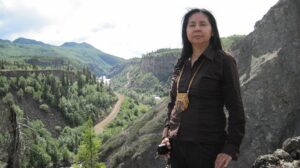Lakehead University launches new Indigenous Law and Justice Institute

By Rick Garrick
THUNDER BAY — Lakehead University Bora Laskin Faculty of Law assistant professor Nancy Sandy looks forward to expanding Indigenous law course offerings in the curriculum through the newly created Indigenous Law and Justice Institute. Sandy, a Secwépemc citizen from B.C., was announced as the director of the Indigenous Law and Justice Institute, the Maamawi Bimosewag – They Walk Together, which begins operations on April 1, on March 24.
“Currently there’s not a big enough course offering and we’re just expanding into this area because of the Truth and Reconciliation (TRC) Call to Action number 50,” Sandy says. “It’s really important in order for us to establish our own Indigenous legal orders and laws in our law schools and have people recognizing those that existed and continue to exist in our communities.”
TRC Call to Action number 50 states, “In keeping with the United Nations Declaration on the Rights of Indigenous Peoples, we call upon the federal government, in collaboration with Aboriginal organizations, to fund the establishment of Indigenous law institutes for the development, use and understanding of Indigenous laws and access to justice in accordance with the unique cultures of Aboriginal peoples in Canada.”
“A lot of people make a mistake and they think of Aboriginal law as Indigenous law, but it isn’t — it’s Canadian law that applies to our rights as Indigenous people,” Sandy says. “Indigenous legal orders and laws pre-existed Canadian law.”
Sandy says the Institute will also hold a law camp that will engage faculty and community in Indigenous land law. Building and sustaining relationships is the first pillar of the Institute’s work.
“That’s just the start of what I anticipate is going be a much bigger program down the road,” Sandy says. “First of all, we are doing summer courses for Indigenous students that are entering law school, and those courses are to replace what was [previously offered] at the University of Saskatchewan. They had a program there for Indigenous students entering regular law school and it was there to help them become more successful.”
The second pillar of the Institute is focused on land-based learning.
“The second level is to start working with communities to start doing the research in community about their laws within the communities in various areas,” Sandy says. “So then we can develop curriculum, so that curriculum can be then be introduced into the main courses of the law school.”
Jula Hughes, dean of the Bora Laskin Faculty of Law, says it is important to have more land-based learning at Bora Laskin.
“One of the things that the Indigenous advisory council (Anishinawbe Omaa Minowaywin) has been saying to me as a dean … is that it is really important for the students to come to the land and really learn with Elders and learn with Knowledge Keepers from communities on the land,” Hughes says. “That is a really important component of it so we are really looking forward to being able to do that.”
The third pillar of the Institute is focused on fostering a lively research environment for students, community-based researchers and faculty in the area of Indigenous law.
“The last part is really about making sure that students learn how to research Indigenous law and how to argue it in court,” Hughes says. “We are seeing that the courts are picking this up and so it is going to be important for them to really get comfortable finding out what is the Anishinabe law on environmental protection or international law or anything like that and then being able to argue those things as part of their regular practice.”
Bora Laskin received support for the Institute from its Indigenous partner communities and organizations, including Anishinabek Nation, Fort William First Nation, Grand Council Treaty #3, Métis Nation of Ontario, Nishnawbe Aski Nation, and Chiefs of Ontario, and up to $437,139 in funding through the federal government’s Justice Partnership and Innovation Program.


